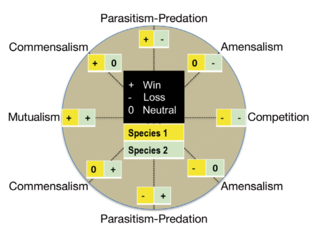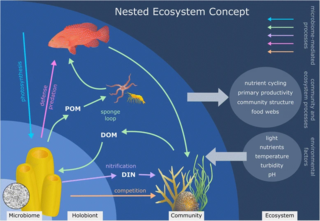
The Max Planck Institute for Terrestrial Microbiology is a research institute for terrestrial microbiology in Marburg, Germany. It was founded in 1991 by Rudolf K. Thauer and is one of 80 institutes in the Max Planck Society (Max-Planck-Gesellschaft). Its sister institute is the Max Planck Institute for Marine Microbiology, which was founded a year later in 1992 in Bremen.

Gammaproteobacteria is a class of bacteria in the phylum Pseudomonadota. It contains about 250 genera, which makes it the most genus-rich taxon of the Prokaryotes. Several medically, ecologically, and scientifically important groups of bacteria belong to this class. All members of this class are Gram-negative. It is the most phylogenetically and physiologically diverse class of the Pseudomonadota.
The Max Planck Institute for Marine Microbiology is located in Bremen, Germany. It was founded in 1992, almost a year after the foundation of its sister institute, the Max Planck Institute for Terrestrial Microbiology at Marburg. In 1996, the institute moved into new buildings at the campus of the University of Bremen. It is one of 80 institutes in the Max Planck Society.

Antje Boetius is a German marine biologist. She is a professor of geomicrobiology at the Max Planck Institute for Marine Microbiology, University of Bremen. Boetius received the Gottfried Wilhelm Leibniz Prize in March 2009 for her study of sea bed microorganisms that affect the global climate. She is also the director of Germany's polar research hub, the Alfred Wegener Institute.

Olavius algarvensis is a species of gutless oligochaete worm in the family Tubificidae which depends on symbiotic bacteria for its nutrition.

Paracatenula is a genus of millimeter sized free-living marine gutless catenulid flatworms.

A microbiome is the community of microorganisms that can usually be found living together in any given habitat. It was defined more precisely in 1988 by Whipps et al. as "a characteristic microbial community occupying a reasonably well-defined habitat which has distinct physio-chemical properties. The term thus not only refers to the microorganisms involved but also encompasses their theatre of activity". In 2020, an international panel of experts published the outcome of their discussions on the definition of the microbiome. They proposed a definition of the microbiome based on a revival of the "compact, clear, and comprehensive description of the term" as originally provided by Whipps et al., but supplemented with two explanatory paragraphs. The first explanatory paragraph pronounces the dynamic character of the microbiome, and the second explanatory paragraph clearly separates the term microbiota from the term microbiome.
Rudolf Amann is a German biochemistriest and microbiologist. He is director of Max Planck Institute for Marine Microbiology (MPIMM) in Bremen and Professor for Microbial Ecology at the University of Bremen.

Microbial symbiosis in marine animals was not discovered until 1981. In the time following, symbiotic relationships between marine invertebrates and chemoautotrophic bacteria have been found in a variety of ecosystems, ranging from shallow coastal waters to deep-sea hydrothermal vents. Symbiosis is a way for marine organisms to find creative ways to survive in a very dynamic environment. They are different in relation to how dependent the organisms are on each other or how they are associated. It is also considered a selective force behind evolution in some scientific aspects. The symbiotic relationships of organisms has the ability to change behavior, morphology and metabolic pathways. With increased recognition and research, new terminology also arises, such as holobiont, which the relationship between a host and its symbionts as one grouping. Many scientists will look at the hologenome, which is the combined genetic information of the host and its symbionts. These terms are more commonly used to describe microbial symbionts.
Olavius finitimus is a species of oligochaete worm, first found in Belize, on the Caribbean side of Central America.
Stilbonematinae is a subfamily of the nematode worm family Desmodoridae that is notable for its symbiosis with sulfur-oxidizing bacteria.
Astomonema is a genus of nematode worms in the family Siphonolaimidae. They lack a mouth or conventional digestive tract, but contain symbiotic sulfur-oxidizing bacteria that serve as their primary food source. They live in the marine interstitial habitat.
Margaret McFall-Ngai is an American animal physiologist and biochemist best-known for her work related to the symbiotic relationship between Hawaiian bobtail squid, Euprymna scolopes and bioluminescent bacteria, Vibrio fischeri. Her research helped expand the microbiology field, primarily focused on pathogenicity and decomposition at the time, to include positive microbial associations. She currently is a professor at PBRC’s Kewalo Marine Laboratory and director of the Pacific Biosciences Research Program at the University of Hawaiʻi at Mānoa.

All animals on Earth form associations with microorganisms, including protists, bacteria, archaea, fungi, and viruses. In the ocean, animal–microbial relationships were historically explored in single host–symbiont systems. However, new explorations into the diversity of marine microorganisms associating with diverse marine animal hosts is moving the field into studies that address interactions between the animal host and a more multi-member microbiome. The potential for microbiomes to influence the health, physiology, behavior, and ecology of marine animals could alter current understandings of how marine animals adapt to change, and especially the growing climate-related and anthropogenic-induced changes already impacting the ocean environment.

Olavius is a genus of oligochaete worms, first described by Christer Erséus in 1984.
Phallodrilinae is a subfamily of clitellate oligochaete worms.

The holobiont concept is a renewed paradigm in biology that can help to describe and understand complex systems, like the host-microbe interactions that play crucial roles in marine ecosystems. However, there is still little understanding of the mechanisms that govern these relationships, the evolutionary processes that shape them and their ecological consequences. The holobiont concept posits that a host and its associated microbiota with which it interacts, form a holobiont, and have to be studied together as a coherent biological and functional unit to understand its biology, ecology, and evolution.
Hydrogen sulfide chemosynthesis is a form of chemosynthesis which uses hydrogen sulfide. It is common in hydrothermal vent microbial communities Due to the lack of light in these environments this is predominant over photosynthesis

Mina Bizic is an environmental microbiologist with particular interest in aquatic systems. She is mostly known for her work on organic matter particles and oxic methane production. She was named a fellow of the Association for the Sciences of Limnology and Oceanography (ASLO) in 2022, and is serving on the ASLO board of directors where she is chairing the Early Career Committee.

Sponge microbiomes are diverse communities of microorganisms in symbiotic association with marine sponges as their hosts. These microorganisms include bacteria, archaea, fungi, viruses, among others. The sponges have the ability to filter seawater and recycle nutrients while providing a safe habitat to many microorganisms, which provide the sponge host with fixed nitrogen and carbon, and stimulates the immune system. Together, a sponge and its microbiome form a holobiont, with a single sponge often containing more than 40 bacterial phyla, making sponge microbial environments a diverse and dense community. Furthermore, individual holobionts work hand in hand with other near holobionts becoming a nested ecosystem, affecting the environment at multiple scales.









